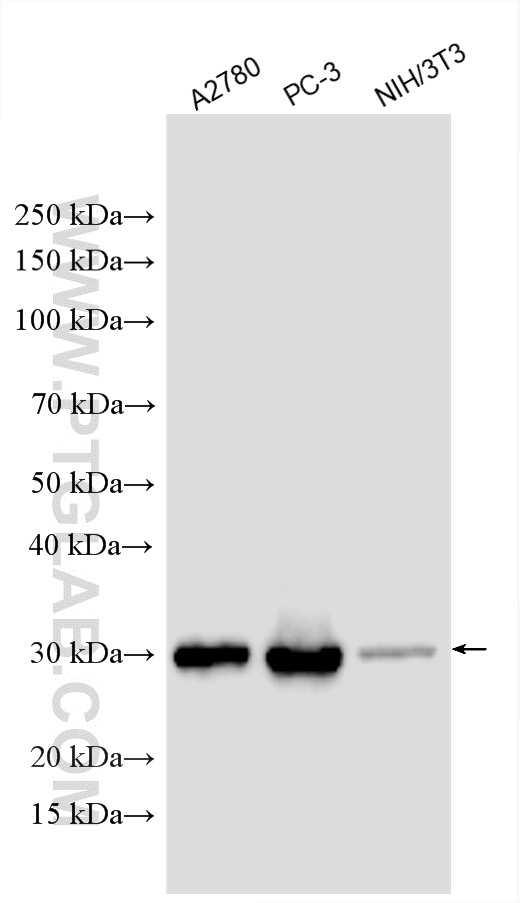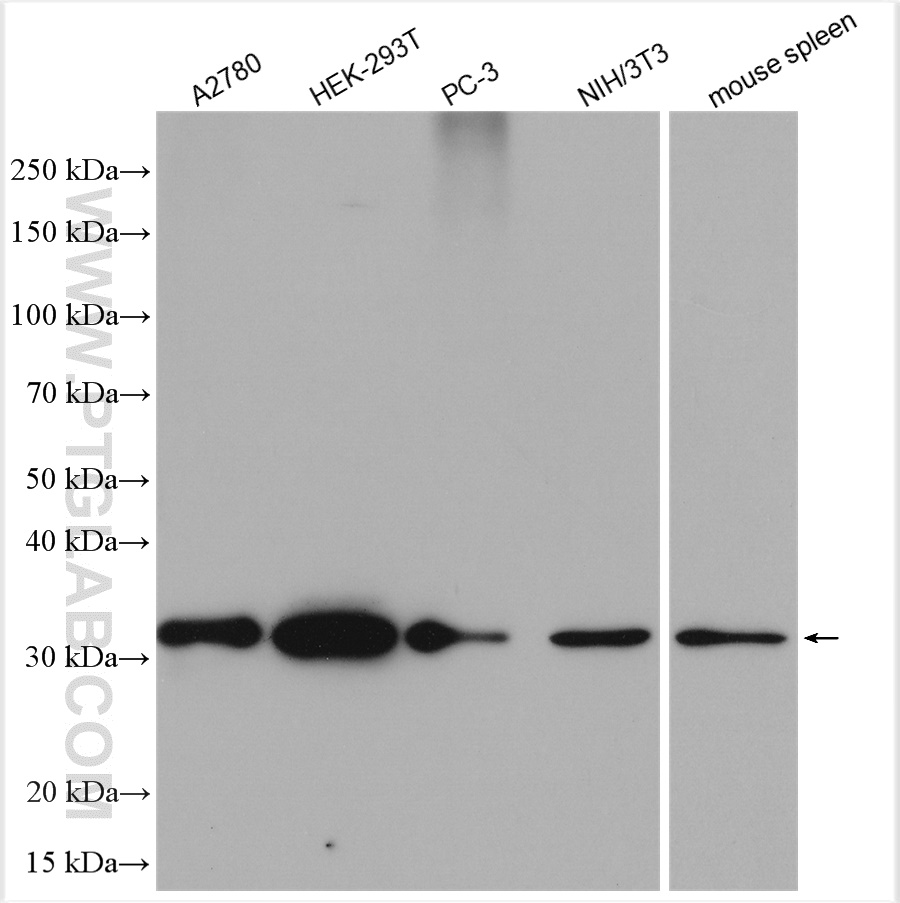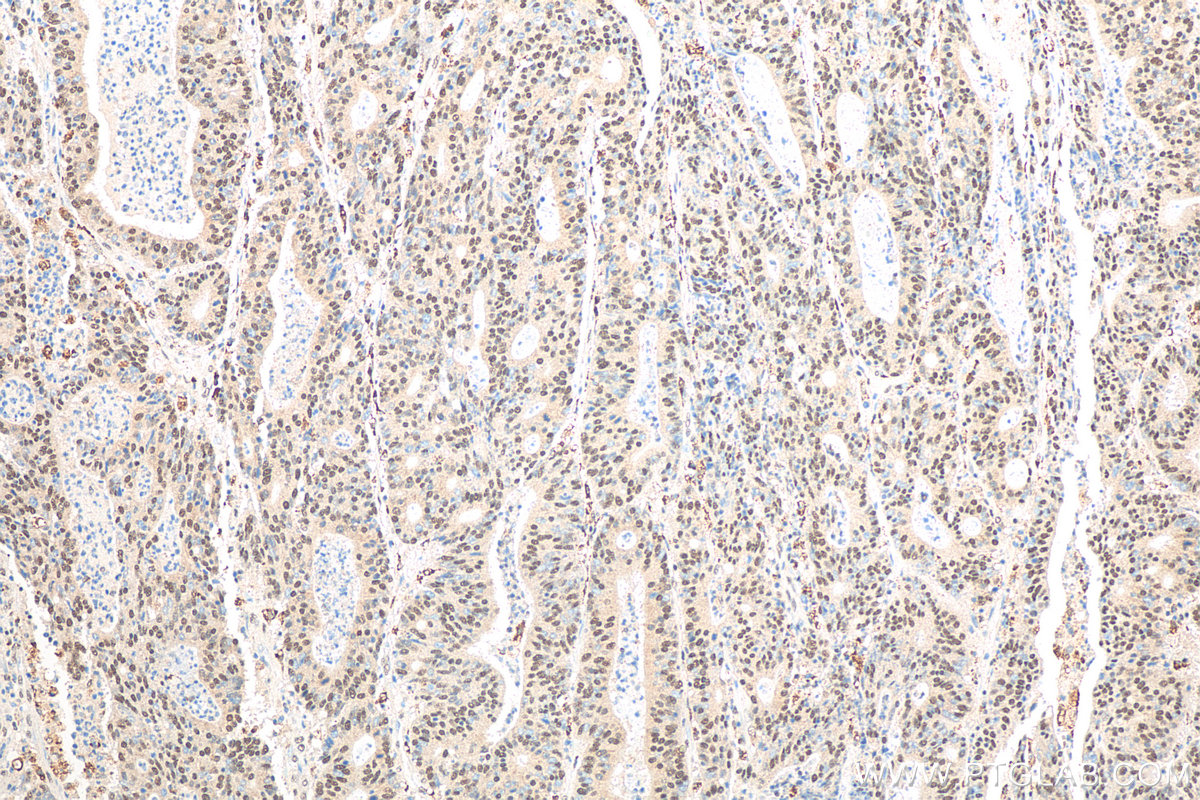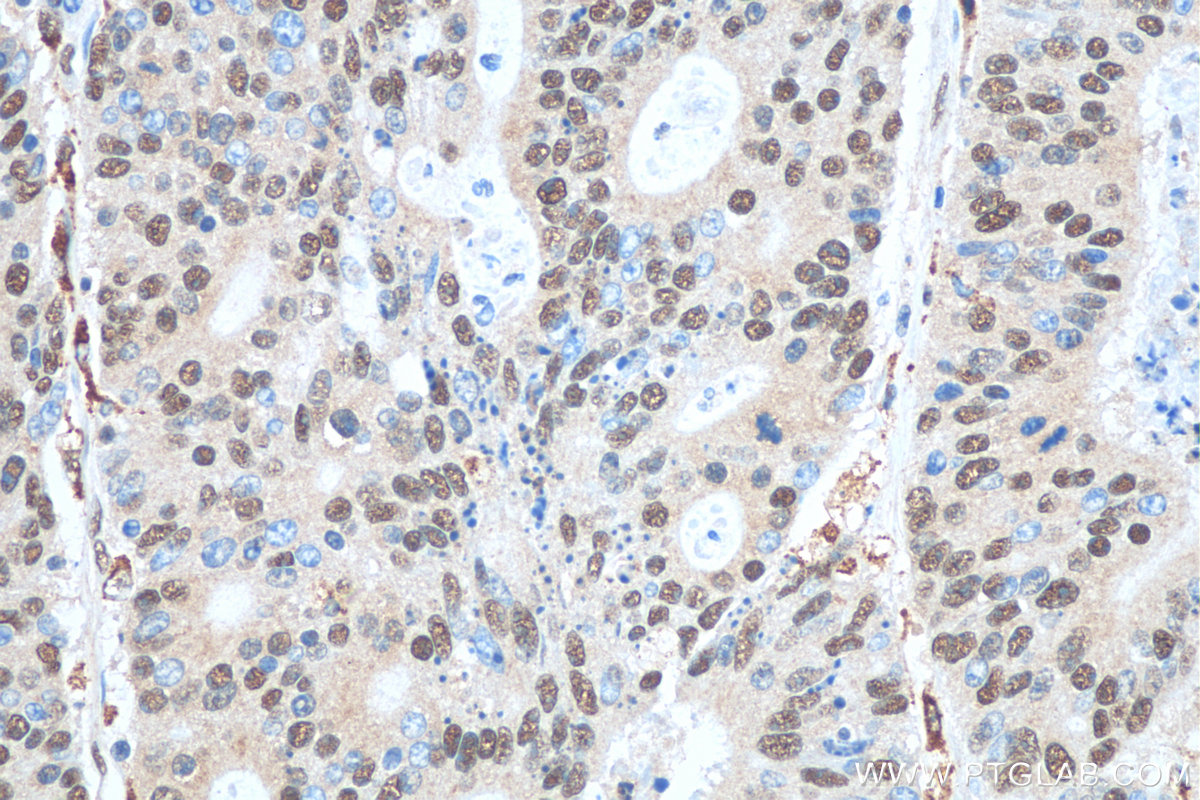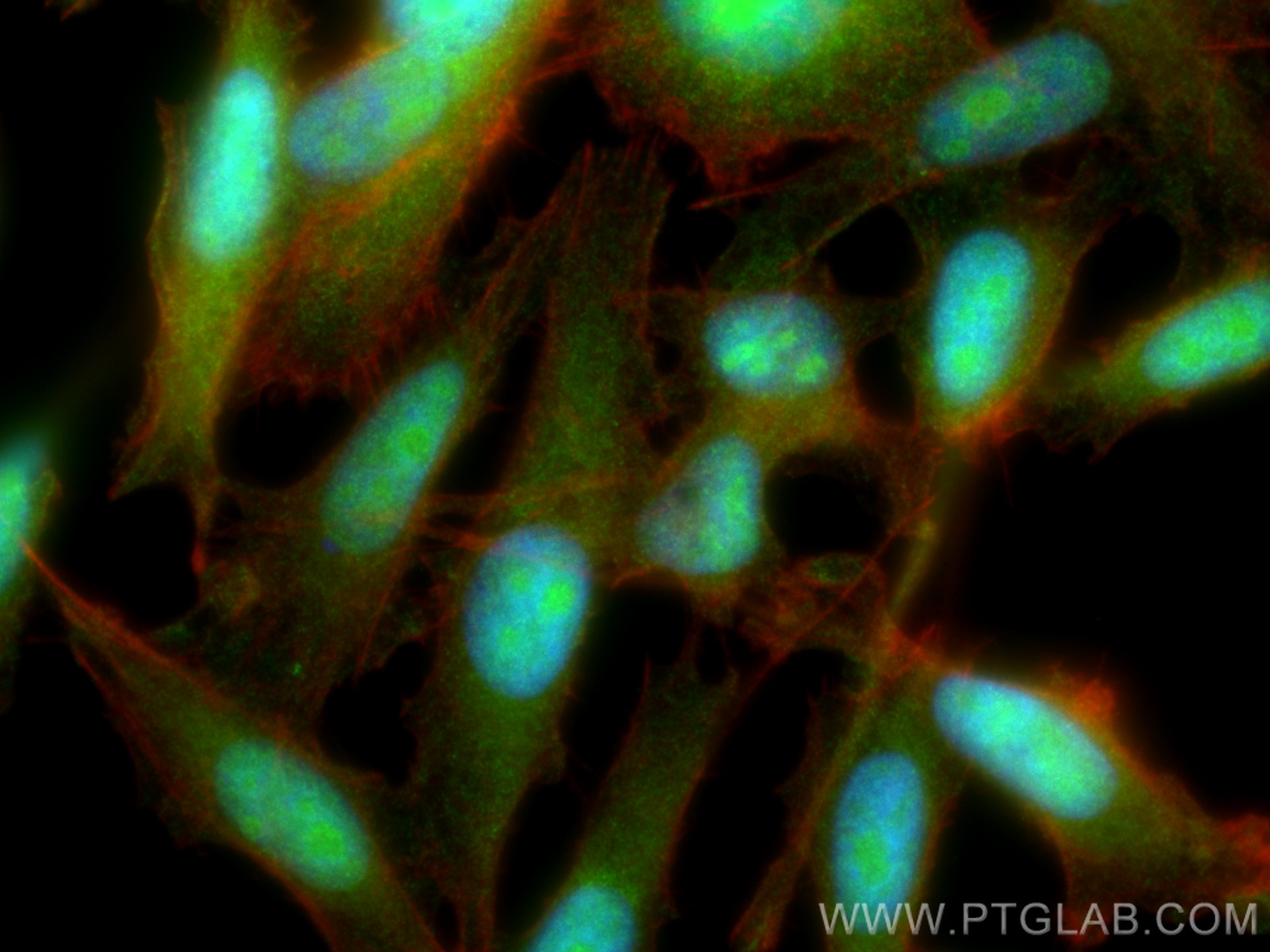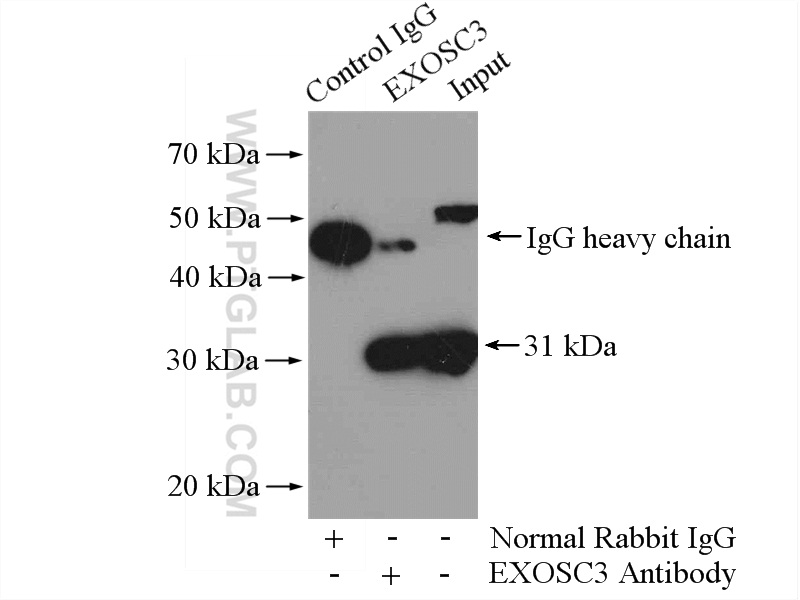验证数据展示
经过测试的应用
| Positive WB detected in | A2780 cells, HEK-293T cells, PC-3 cells, NIH/3T3 cells, mouse spleen tissue |
| Positive IP detected in | A2780 cells |
| Positive IF/ICC detected in | PC-3 cells |
推荐稀释比
| 应用 | 推荐稀释比 |
|---|---|
| Western Blot (WB) | WB : 1:1000-1:4000 |
| Immunoprecipitation (IP) | IP : 0.5-4.0 ug for 1.0-3.0 mg of total protein lysate |
| Immunofluorescence (IF)/ICC | IF/ICC : 1:200-1:800 |
| It is recommended that this reagent should be titrated in each testing system to obtain optimal results. | |
| Sample-dependent, Check data in validation data gallery. | |
产品信息
15062-1-AP targets EXOSC3 in WB, IF/ICC, IP, ELISA applications and shows reactivity with human, mouse, rat samples.
| 经测试应用 | WB, IF/ICC, IP, ELISA Application Description |
| 文献引用应用 | WB, IF |
| 经测试反应性 | human, mouse, rat |
| 文献引用反应性 | human, mouse |
| 免疫原 |
CatNo: Ag7065 Product name: Recombinant human EXOSC3 protein Source: e coli.-derived, PGEX-4T Tag: GST Domain: 1-275 aa of BC002437 Sequence: MAEPASVAAESLAGSRARAARTVLGQVVLPGEELLLPEQEDAEGPGGAVERPLSLNARACSRVRVVCGPGLRRCGDRLLVTKCGRLRHKEPGSGSGGGVYWVDSQQKRYVPVKGDHVIGIVTAKSGDIFKVDVGGSEPASLSYLSFEGATKRNRPNVQVGDLIYGQFVVANKDMEPEMVCIDSCGRANGMGVIGQDGLLFKVTLGLIRKLLAPDCEIIQEVGKLYPLEIVFGMNGRIWVKAKTIQQTLILANILEACEHMTSDQRKQIFSRLAES 种属同源性预测 |
| 宿主/亚型 | Rabbit / IgG |
| 抗体类别 | Polyclonal |
| 产品类型 | Antibody |
| 全称 | exosome component 3 |
| 别名 | Ribosomal RNA-processing protein 40, Exosome complex component RRP40, EXOSC 3, CGI-102 |
| 计算分子量 | 30 kDa |
| 观测分子量 | 31 kDa |
| GenBank蛋白编号 | BC002437 |
| 基因名称 | EXOSC3 |
| Gene ID (NCBI) | 51010 |
| RRID | AB_2278183 |
| 偶联类型 | Unconjugated |
| 形式 | Liquid |
| 纯化方式 | Antigen affinity purification |
| UNIPROT ID | Q9NQT5 |
| 储存缓冲液 | PBS with 0.02% sodium azide and 50% glycerol, pH 7.3. |
| 储存条件 | Store at -20°C. Stable for one year after shipment. Aliquoting is unnecessary for -20oC storage. |
背景介绍
RNA exosomes are multi-subunit complexes conserved throughout evolution, and they are emerging as the major cellular machinery for processing, surveillance and turnover of a diverse spectrum of coding and noncoding RNA substrates essential for viability[PMID:22544365]. In the nucleus, the RNA exosome complex is involved in proper maturation of stable RNA species such as rRNA, snRNA and snoRNA, in the elimination of RNA processing by-products and non-coding 'pervasive' transcripts [PMID:11782436]. EXOSC3 is a non-catalytic component of the RNA exosome complex which has 3'->5' exoribonuclease activity and involves in a multitude of cellular RNA processing and degradation events. EXOSC3 as peripheral part of the Exo-9 complex stabilizes the hexameric ring of Rnase PH-domain subunits through contacts with EXOSC9 and EXOSC5 [PMID:21255825].
实验方案
| Product Specific Protocols | |
|---|---|
| IF protocol for EXOSC3 antibody 15062-1-AP | Download protocol |
| IHC protocol for EXOSC3 antibody 15062-1-AP | Download protocol |
| IP protocol for EXOSC3 antibody 15062-1-AP | Download protocol |
| WB protocol for EXOSC3 antibody 15062-1-AP | Download protocol |
| Standard Protocols | |
|---|---|
| Click here to view our Standard Protocols |
发表文章
| Species | Application | Title |
|---|---|---|
Mol Cell Integrator is a genome-wide attenuator of non-productive transcription.
| ||
Nucleic Acids Res The RNA exosome contributes to gene expression regulation during stem cell differentiation. | ||
Nucleic Acids Res A short splicing isoform of HBS1L links the cytoplasmic exosome and SKI complexes in humans. | ||
Nat Commun EXOSC8 mutations alter mRNA metabolism and cause hypomyelination with spinal muscular atrophy and cerebellar hypoplasia. | ||
Nucleic Acids Res A short splicing isoform of HBS1L links the cytoplasmic exosome and SKI complexes in humans. |

